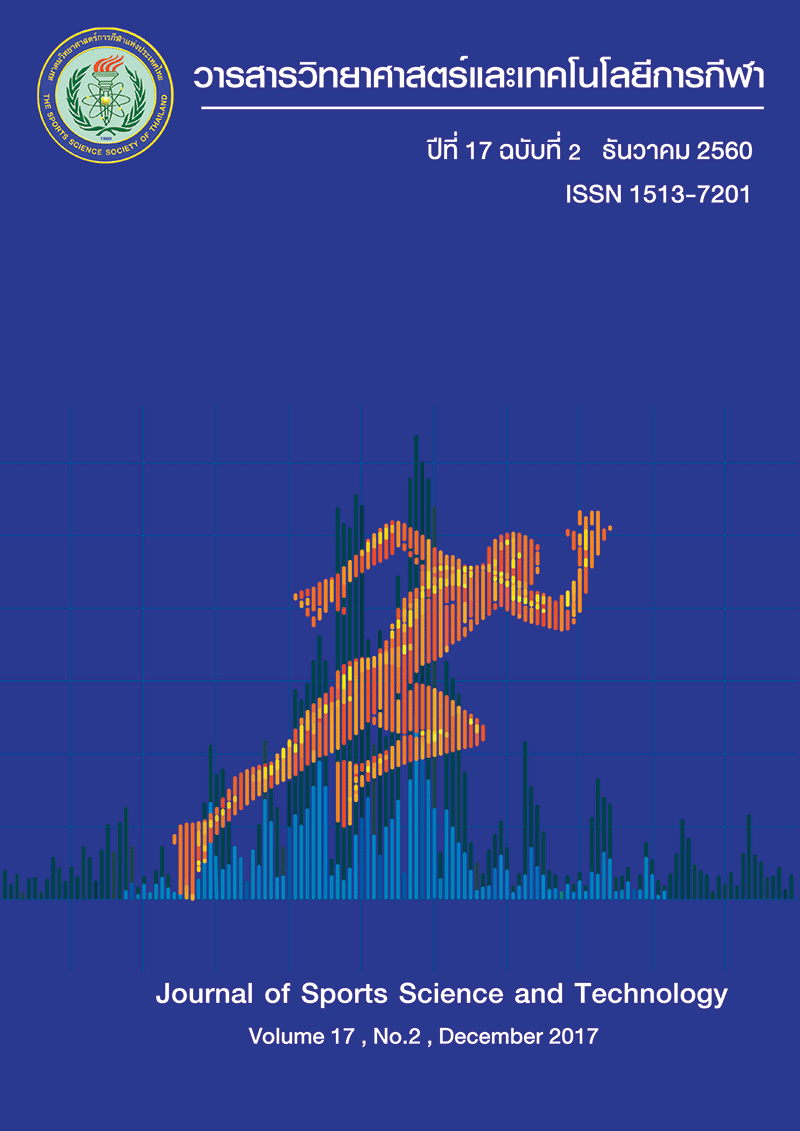EFFECTS OF 8 WEEKS MODIFIED HIGH-INTENSITY CIRCUIT TRAINING USING BODYWEIGHT ON BODY WEIGHT, BODY CIRCUMFERENCE AND RESTING METABOLIC RATE IN SEDENTARY OBESE WOMAN
Keywords:
Exercise Position / Weight Loss / Bodyweight / Waist/Hip circumference RatioAbstract
Objective: The present study was to investigate effects of 8-week modified high intensity circuit training using bodyweight (modified HICT BW) on body weight (BW), Waist/Hip circumference ratio (WHR), body circumferences and resting metabolic rate in sedentary obese women.
Methods: Twenty-four sedentary female (aged between 20 and 40 years) who have body mass index between 25-29.9 kg/m2 participated and were divided into untrained groups and trained groups. The trained group performed modified HICTBW program for 8 weeks. All parameters were measured before and after the 8-week study period in both groups
Results: There was a significant increase in resting metabolic rate after 8 weeks of modified HICT BW training (p<0.05), however, there were no significant differences in BW, WHR and body circumference in trained group when compared before and after an eight-week training.
Discussion: An eight-week modified HICT BW exerts the beneficial effects on an improvement of resting metabolic rate, but not body weight loss and changes in body circumference in sedentary obese people.
(Journal of Sports Science and Technology 2017; 17(2): 109-120)
Keywords: Exercise Position / Weight Loss / Bodyweight / Waist/Hip circumference Ratio
*Corresponding author:Amornpan AJJIMAPORN
College of Sports Science and Technology,
Mahidol University, Nakhon Pathom 73170
E-mail: amornpan.ajj@mahidol.edu
References
2. The Sedentary Behaviour Research Network (SBRN). What is Sedentary Behavior?. 2017 [updated 2017; cited 2017 November 1st, 2017]; Available from: http://www.sedentarybehaviour.org/what-is-sedentary-behaviour/.
3. Tremblay MS, Aubert S, Barnes JD, Saunders TJ, Carson V, Latimer-Cheung AE, et al. Sedentary Behavior Research Network (SBRN) - Terminology Consensus Project process and outcome. Int J Behav Nutr Phys Act. 2017;14(1):75.
4. รายงานผลการวิจัยโครงการพัฒนาระบบเฝ้าระวังติดตามพฤติกรรมด้านกิจกรรมทางกายของประชากรไทย มหาวิทยาลัยมหิดลพ.ศ. 2558. นครปฐม: สถาบันวิจัยประชากรและสังคม มหาวิทยาลัยมหิดล; 2558.
5. Organization WH. Global Physical Activity Questionnaire (GPAQ) Analysis Guide. World Health Organization; 2011 [updated 2011; cited]; Available from: http://www.who.int/chp/steps/resources/GPAQ_Analysis_Guide.pdf.
6. Garber CE, Blissmer B, Deschenes MR, Franklin BA, Lamonte MJ, Lee IM, et al. American College of Sports Medicine position stand. Quantity and quality of exercise for developing and maintaining cardiorespiratory, musculoskeletal, and neuromotor fitness in apparently healthy adults: guidance for prescribing exercise. Med Sci Sports Exerc. 2011;43(7):1334-59.
7. Perry CG, Heigenhauser GJ, Bonen A, Spriet LL. High-intensity aerobic interval training increases fat and carbohydrate metabolic capacities in human skeletal muscle. Appl Physiol Nutr Metab. 2008;33(6):1112-23.
8. Gibala MJ, Little JP, Macdonald MJ, Hawley JA. Physiological adaptations to low-volume, high-intensity interval training in health and disease. J Physiol. 2012 ;590(5):1077-84.
9. Paoli A, Pacelli QF, Moro T, Marcolin G, Neri M, Battaglia G, et al. Effects of high-intensity circuit training, low-intensity circuit training and endurance training on blood pressure and lipoproteins in middle-aged overweight men. Lipids Health Dis. 2013; 12:131.
10. Klika B, Jordan C. HIGH-INTENSITY CIRCUIT TRAINING USING BODY WEIGHT: Maximum Results With Minimal Investment. ACSM's Health & Fitness Journal. 2013;17(3):8-13.
11. Schmidt D, Anderson K, Graff M, Strutz V. The effect of high-intensity circuit training on physical fitness. J Sports Med Phys Fitness. 2016;56(5):534-40.
12. Wang T. Effects of high intensity circuit training on body composition, cardiopulmonary fitness and metabolic syndrome markers in middle aged male. Medicine & Science in Sports & Exercise. 2016;48(55):988-9.
13. โครงการ SizeThailand. ผลการสำรวจรูปร่างทั่วประเทศ. ศูนย์เทคโนโลยีอิเล็กทรอนิกส์และคอมพิวเตอร์แห่งชาติ; 2000 [updated 2000; cited 2017 October 13th]; Available from http://www.sizethailand.org/region_all.html.
14. Weisell RC. Body mass index as an indicator of obesity. Asia Pacific Journal of Clinical Nutrition. 2002;11:S681-S4.
15. Miller MB, Pearcey GE, Cahill F, McCarthy H, Stratton SB, Noftall JC, et al. The effect of a short-term high-intensity circuit training program on work capacity, body composition, and blood profiles in sedentary obese men: a pilot study. Biomed Res Int. 2014;2014:191797.
16. Paoli A, Pacelli F, Bargossi AM, Marcolin G, Guzzinati S, Neri M, et al. Effects of three distinct protocols of fitness training on body composition, strength and blood lactate. J Sports Med Phys Fitness. 2010;50(1):43-5.
17. Karastergiou K, Fried SK, Xie H, Lee MJ, Divoux A, Rosencrantz MA, et al. Distinct developmental signatures of human abdominal and gluteal subcutaneous adipose tissue depots. J Clin Endocrinol Metab. 2013;98(1):362-71.
18. Henry CJ. Basal metabolic rate studies in humans: measurement and development of new equations. Public Health Nutr. 2005;8(7A):1133-52.
19. McCarthy RT. The metabolic cost of maintaining five fixed body positions. Nurs Res. 1968;17(6):539-44.
20. Levine JA, Schleusner SJ, Jensen MD. Energy expenditure of nonexercise activity. Am J Clin Nutr. 2000;72(6):1451-4.
21. Hoffmans M et al. Resting metabolic rate in obese and normal weight women. Int J Obes. 1979;3(2):111-8.
22. Solanki R, Bhise A, Shukla Y, Prabhakar M. Effects of high intensity circuit training using body weight on aerobic fitness and muscular endurance in college students. Physiotherapy. 2015;101( Supplement 1):eS1238–eS642.






